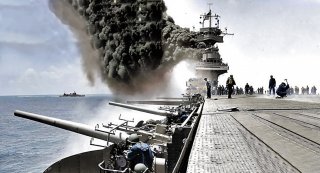How to Kill an Empire: The U.S. Smashed Imperial Japan At Midway
Midway reversed the flow of war in the Pacific from east to west, and operations kept flowing westerly until ultimate Allied victory in 1945.
And lastly, Spruance had an acute sense of when he had fulfilled his duty and risked pushing his luck too far. Having pummeled the Kidō Butai, he declined to launch additional attacks on the powerful IJN battleship and cruiser forces still lurking on the high seas. He had abided by the principle of calculated risk and done the enemy far more harm than his force had been done. Accordingly, the U.S. task forces retired to fight another day. Similarly, two years later, having been assigned to protect U.S. amphibious forces lumbering toward the Philippine Islands, Spruance again did the Japanese grave damage.
And again forbore to risk his fleet further once its mission had been accomplished. He was correct again. In short: like all masterful opportunists, Spruance had a knack for accepting fortune’s favor without getting greedy. Germany’s Iron Chancellor—himself no slouch at courting risk without overdoing it—could only approve in his gruff way.
Will Emmerich’s film convey this strategic brilliance alongside planes and ships exploding? Grab your popcorn—and let’s see.
James Holmes is J. C. Wylie Chair of Maritime Strategy at the Naval War College and the author of A Brief Guide to Maritime Strategy, due out next month. The views voiced here are his alone.
Image: Wikimedia Commons

